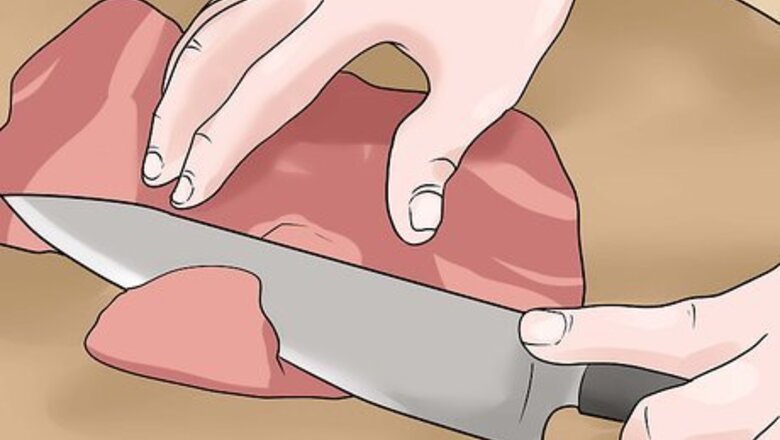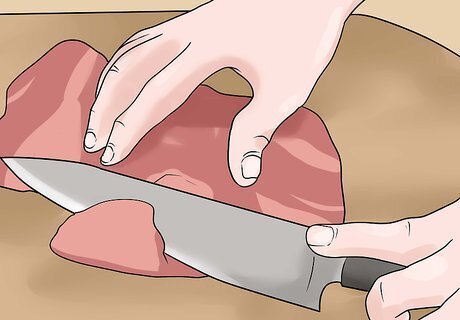
views
Protein-Rich Food Sources

Animal-based protein Proteins come in one of two forms: complete and incomplete, depending on how many amino acids they contain (amino acids are substances that help build protein). Since the human body can’t naturally produce these amino acids independently, it’s important to eat complete proteins—like animal-based proteins—to help your body stay healthy and strong. Some animal-based protein sources include: Chicken breast (per 100 grams): 22.5 grams Ground turkey (per 100 grams): 17.3 grams Atlantic salmon (per 100 grams): 20.3 grams Ground beef (80/20, per 100 grams): 17.5 grams Ground pork (per 100 grams): 17.8 grams Eggs (per 100 grams): 10.7 grams per egg
Plant-based protein While plant-based proteins aren’t considered “complete” sources of protein, they can still be a great way to add more protein to your diet. Some great plant-based protein sources include: Fried tofu (per 100 grams): 18.8 grams Black beans (per 100 grams): 24.4 grams Cannellini beans (per 100 grams): 21.6 grams Lentils (per 100 grams): 23.6 grams Chickpeas (per 100 grams): 21.3 grams Sunflower seeds (per 100 grams): 18.9 grams Peanuts (per 100 grams): 23.2 grams Cashews (per 100 grams): 17.4 grams
Dairy products Dairy products can be great sources of complete protein, and come in a variety of forms like: Skim milk (per 100 grams): 3.43 grams Whole milk (per 100 grams): 3.27 grams Soy milk (unsweetened, per 100g): 3.55 grams Greek yogurt (nonfat, per 100 grams): 10.3 grams Cottage cheese (low-fat, per 100 grams): 11 grams Mozzarella cheese (per 100 grams): 23.7 grams Romano cheese (per 100 grams): 31.8 grams grams
Protein powders Protein powders aren’t all they appear to be—although they claim to pack a lot of protein in a small punch, they might also carry harmful ingredients (like mercury, lead, and BPAs). Since protein powders are supplemental and not regulated by the FDA, it’s hard to know if what you’re getting is actually helpful or not. If you do want to give protein powder a try, make sure you’re buying products from trusted brands like Puori or Wicked Protein. Nutritionist Lyssandra Guerra notes how “spinach, baby kale, sesame paste/tahini, medjool dates, coconut water, and coconut cream” are all “nutrient-boosting and delicious ingredients to add to protein shakes. Nutritionist Adrienne Youdim “likes protein powders as an adjunct in general.” She especially likes “whole protein, because it gives you the whole host of amino acids, which are the building blocks of your muscles.”
250 Grams of Protein a Day Meal Plan

Sample breakfast Fill your plate with plenty of protein-rich breakfast foods, like an omelette (with 2+ eggs—5 to 7.5 grams of protein per egg) with 1 oz (28.35 g) of Romano cheese (around 9 grams of protein) and 1 slice of ham (around 3.5 grams of protein), along with a container of Greek yogurt (16 grams of protein) with protein-rich toppings like chia seeds (4.5 grams of protein per ounce), sunflower seeds (around 5.5 grams of protein per ounce), and/or walnuts (around 4 grams of protein per ounce). Add some lean protein sides like turkey bacon (around 5 grams of protein per 2 slices) or turkey sausage (around 9 grams of protein per 2 links) to up your protein intake. Total protein: 55 to 59 grams Shopping list: Eggs Butter Romano cheese Minced ham Greek yogurt Chia seeds Sunflower seeds Walnuts Turkey bacon Turkey sausage While you can add more eggs to your omelette to up the protein amount, health professionals agree that many people in good health can enjoy up to 7 eggs a week without having to worry about any health complications. The cholesterol content in eggs can be chalked up to the yolk, though, so feel free to stick with just egg whites for a protein-packed, cholesterol-free breakfast option.
Sample lunch Enjoy tacos or burritos with whole wheat tortillas (4 grams of protein per tortilla) featuring a protein like chicken breast (around 19 grams of protein for a 3 oz/85 gram serving) as your main source of protein, accompanied by other protein-rich ingredients like black beans or pinto beans (8 grams of protein per ½ cup for both) and 1 oz (28.35 g) of Romano cheese (around 9 grams of protein). Total protein: 40 grams Shopping list: Whole wheat tortillas Chicken breast Black beans or pinto beans Romano cheese
Sample dinner Fry up some tofu (25 grams of protein for 10 pieces) for a vegetarian-friendly meal, or prepare another high-protein alternative like salmon (40 grams of protein for ½ of a fillet). Enjoy your main course with a glass of skim milk (8.5 grams of protein per cup/237 mL) and some protein-packed sides, like some roasted chickpeas (6 grams of protein per serving) and quinoa (8 grams of protein per cup). Total protein: 47.5 to 62.5 grams Shopping list: Tofu Salmon Skim milk Chickpeas Quinoa
Sample snacks Snacks are a great opportunity to add customizable amounts of protein to your diet. Choose from options throughout the day like: Hummus (around 5 grams for 4 US tbsp (59 mL)) Mozzarella cheese (around 23.7 grams of protein per 100 grams) Jerky (around 9.5 grams of protein per 1 oz/28.35 grams) Hard-boiled egg (around 6.5 grams of protein per egg) Cottage cheese (11 grams of protein per 100 grams) Peanut butter on whole-grain toast (11 grams of protein) Protein shake (around 10 to 20 grams of protein for each scoop)
Tips for Adding More Protein to Your Diet

Talk with your doctor before embarking on a really high-protein diet. Protein is an important part of a healthy and well-rounded diet—but, like many things in life, consuming protein can lead to some pretty serious health issues, like dehydration and even kidney problems. Discuss your fitness and wellness goals with your healthcare provider to get a better idea of how much protein you really need. If you’re hoping to build a lot of muscle, your doctor can tell you if a daily 250-gram protein goal is overkill for your fitness goals. Nutritionist and therapist Mindy Lu notes how there isn’t “a one-size-fits-all” approach “when it comes to food for somebody.” She suggests giving intuitive eating a try, since “it’s really about a lot of experimenting.”
Split your daily protein intake between all your meals and snacks. While it may be tempting to dump a heaping scoop of protein powder into a shake and call it a day, it’s not a great idea to get a day’s worth of protein in one sitting. Your body has an easier time processing protein in smaller amounts at a time (around 15-30 grams is the sweet spot), so make sure you’re fitting in protein-rich meals and snacks in throughout the day. In addition to breakfast, lunch, and dinner, you might need to set up separate snack times to make space for all the extra protein you’re trying to eat.
Incorporate as much lean protein as you can. Lean proteins are less heavy in saturated fats, making them a healthier option as you plan your upcoming meals. If you’re shopping for red meat (like beef), check the package to see what the lean meat percentage is. Don’t be afraid to check out different stores as you shop! Certain store might have better deals than others when it comes to specific products. If you're grocery shopping on a budget, prioritize picking out your main protein sources first. Then, look for deals on starches and carbs, lots of veggies, and healthy fats like olive oil.
Eat a balanced diet. Part of eating healthy involves eating a balanced diet. Besides eating protein-rich foods, snack on at least 5 servings of fruits and veggies throughout the day, along with high-fiber foods like brown rice and whole-wheat bread. When incorporating oils into your diet, stick with unsaturated ones, like olive oil.
Read nutrition labels to better understand the protein levels of your foods. Nutrition labels are your best friend when it comes to understanding the nutrient content of your food. Check somewhere on or around the food back for a black-and-white label titled “Nutrition Facts.” “Protein” is typically listed above a thick, black bar that separates the fat, cholesterol, sodium, carb, and protein content from the vitamin and mineral content. Some labels may include Daily Value percentages on the far right, which let you know what percentage of protein (or any other nutrient) you’re getting for the whole day. These percentages are based on a 2,000-calorie diet plan, though, and might not be an accurate representation of your dietary goals.
How much protein do I need?

Bodybuilders: 1 to 1.5 grams of protein per 1 kg (2.2 lb) of weight If you’re actively trying to build muscle, nutrition experts recommend capping yourself at eating/drinking 1 to 1.5 grams of protein for every 1 kg (2.2 lb) you weigh. If you weight 200 lb (91 kg), that would be around 91-136.5 grams of protein per day; for someone who weighs 275 lb (125 kg), that would be around 125-187.5 grams. If you use the imperial system of measurement, multiply your weight (in pounds) by 0.36 to get your daily recommended protein intake (in grams).
Non-bodybuilders: 0.8 grams of protein per 1 kg (2.2 lb) of weight Believe it or not, you don’t need to eat a crazy-high amount of protein to stay in good shape. Stick to this nutritional rule of thumb, instead: 0.8 grams of protein for every 1 kg (2.2 lb) of weight. For some who weighs 140 lb (63.5 kg), that would be around 51 grams of protein; for someone who weighs, 250 lb (113 kg), that would be around 90.4 grams. What if I have diabetes? No worries—the 0.8 grams of protein per 1 kg (2.2 lb) of weight should still apply to you, but always talk to your doctor if you’d like to change up a component of your diet. What if I’m trying to lose weight? Try skewing your daily protein intake slightly higher to around 1-1.2 grams of protein per 1 kg (2.2 lb) of weight. To be safe, though, discuss your weight loss and diet plans with your doctor before getting started. What if I’m pregnant? Aim somewhere between 75 and 100 grams of protein each day. Always confer with your OB-GYN doctor before making any major adjustments to your diet, though. What if I’m on the older side? Shoot for 1-1.2 grams of protein for every 1 kg (2.2 lb) of body weight.
Negative Effects of Excess Protein

Dehydration From a biological standpoint, your kidneys help flush out all unwanted substances from your body—a function that requires plenty of fluids. If you aren’t drinking enough water alongside your protein, you might start feeling a bit dehydrated as your body juggles this important task (which includes filtering the leftover waste from proteins). Pro tip: While daily hydration requirements ultimately depend on the individual, aim to drink 11.5 cups (2.7 L) if you’re assigned female at birth, and 15.5 cups (3.7 L) if you’re assigned male at birth.
Kidney problems Research shows that eating too much protein can negatively impact your kidneys over time. However, not all protein varieties are created equally—one study particularly highlights how eating excess animal-based protein (e.g., beef, chicken, pork, etc.) can potentially boost your chances of developing End Stage Kidney Disease (ESKD), as opposed to plant-based protein. In the human body, the kidneys are responsible for processing and removing all the extra junk from your blood that your body doesn’t need, like leftover waste from protein. Now, imagine overloading your body with a ton of excess protein. Your kidneys may struggle to keep up!
Bone density issues Your kidneys play an important role in keeping your blood at a healthy pH; to do so, the kidneys transfer bicarbonate (a basic substance) to the blood and hydrogen ions (an acidic substance) to your urine. When dealing with too much protein, however, the kidneys produce too much acid, which can negatively impact your calcium levels and bone density. A simple way to prevent this (besides eating less protein) includes eating foods with an alkaline (basic) effect, like potassium-rich veggies and fruits. Raisins, apricots, avocados, spinach, broccoli, winter squash, bananas, and oranges are just a few excellent options to consider.

Red meat-related complications While red meat undeniably has useful nutrients (like protein, iron, B12 vitamins, and zinc), it also comes with some pretty negative health effects, like an increased risk for long-term health issues (like coronary heart disease, stroke, diabetes, and even cancer). If you plan on incorporating red meat into your high-protein diet, do so in moderation. For instance, you might give yourself a small portion of beef or lamb as a side dish while prioritizing a healthier source of protein as the main dish in your meal (e.g., chicken, fish, turkey, etc.).















Comments
0 comment